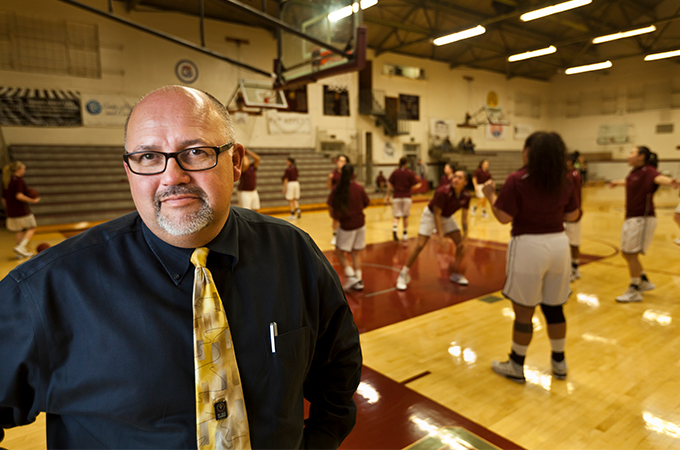Following two life-threatening medical incidents on the University of Redlands main campus, Director of Athletics Jeff Martinez spoke with Katie Olson and Mika Elizabeth Ono of the Bulldog Blog about how Bulldog Athletics prepares for medical emergencies.
Bulldog Blog: How did the need for safety training and equipment first come to your team’s attention?
Jeff Martinez: Emergency preparedness is not new to the department of intercollegiate athletics. I come from a background in athletic training—an allied health profession that certifies and licenses health care professionals in the field of sports medicine. In 1986, we had 240 student-athletes and one athletic trainer—me. For the last 35 years, I’ve expected everyone in our department to be trained in CPR. The Red Cross and the American Heart Association added the automated external defibrillator (AED), so now, when staff members are trained in CPR, they are also trained in use of the AED.
More than 15 years ago, the broader campus became more aware of the importance of this type of training after a Facilities Management employee collapsed and no one knew what to do. By the time the ambulance arrived, he was gone. In response, we created emergency action plans for every space, and the athletic training staff is responsible for overseeing and updating those at least every other year. CPR training occurs every two years, and Assistant Athletic Trainer Sarah Beene is the lead training instructor on our staff—all three of our athletic trainers are CPR instructors.
BB: Could you tell us about the two recent incidents on campus in which AEDs were used?
JM: This past November, In Currier Gym, a senior on the University of Texas at Dallas basketball team with no prior history of medical issues collapsed seven minutes into the game. I was standing across from the scoring table, which is typically where I watch games. We took a shot at our basket and missed, and they got the rebound and made two quick passes and shot a lay-up at the opposite end of the court. The game went from one end of the court to the other pretty fast, and no one realized that nine people went to the other end of the court—not 10.
One of the players from the UT Dallas team had walked over to the bench and collapsed. I walked straight across the court and arrived at the bench just about the same time as assistant athletic trainer Sarah Beene. She looked at the coach and asked the player’s name and if he had any prior history of problems. Sarah assessed him, told me to call 911, and asked her assistant, Arihan Givens, to get the AED. I stepped aside and called 911 and Public Safety. One of the things that was so impressive was the way that Sarah handled the situation—she was in charge.
Since the game had been stopped, we encouraged the teams to go back to their locker rooms and asked the people in the stands to move outside of the gym. There was a group of about 40 middle school students from Moreno Valley, and I remember seeing them walk out of the gym looking over their shoulders. And then, all of a sudden, after five rounds of CPR, he took a breath. Shortly after that, he opened his eyes.
After the fact, information from the AED indicated he had a heart condition. The student returned to Texas with a defibrillator installed in his chest wall and it will be there for the rest of his life. If his heart had stopped while he was driving his car or sitting in the back seat, he wouldn’t have had an AED. Without intervention within three to four minutes, fewer than 10% of people with his condition survive.
BB: That’s amazing. Kudos to your staff! There was a second incident?
JM: The second situation occurred on the tennis courts and involved an older gentleman who collapsed. He was probably one of the most active members of the group he was with, so at first, the others didn’t realize how serious the situation was. A member of our coaching staff was on the next court, but couldn’t see the situation because of the windscreens. When one of the group members asked for help, he went over right away. He started CPR and someone called Public Safety—four Public Safety vehicles have an AED. Unfortunately, the emergency vehicles were delayed and by the time the paramedics arrived, it had been too long. While the gentleman’s heart did respond to the AED, he likely sustained brain damage, and he passed away.
BB: We’re sorry to hear that. How many AEDs are there on campus to respond to these types of medical emergencies?
JM: While I can only speak to the devices in the athletics facilities, I believe there are 23 AEDs across the Redlands campus—in the gym, aquatic center, fitness center, the athlete training room... They are also stored in large gathering spaces such as Memorial Chapel, Orton Center, and the Casa Loma room. Some are mobile so the coaches can take them to practices and there are four Public Safety vehicles that are equipped with AEDs.
BB: Who else on the Redlands campus is trained aside from coaches and athletic trainers?
JM: Most institutions require coaches to be trained, but I’m not sure how many require their administrative assistants and other community members to undergo training like we do. I believe the majority of the Public Safety officers are trained, as are community assistants, resident directors, and building managers and monitors. It’s a best practice here.
Learn more about Bulldog Athletics.






